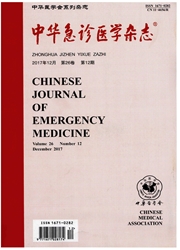

 中文摘要:
中文摘要:
目的研究急性肝衰竭小鼠细胞外组蛋白的水平变化及干预价值。方法选野生型C57BL/6小鼠,经腹腔注射致死剂量的D-氨基半乳糖和脂多糖诱导急性肝衰竭,动态测定血浆中细胞外组蛋白的水平以及肝功能、细胞凋亡等指标;分别给予特异性抗组蛋白H3和H4中和抗体进行干预,并检测小鼠生存率和肝损伤指标以及肿瘤坏死因子TNF-α水平等。结果D-氨基半乳糖和脂多糖联用导致小鼠急性肝衰竭,表现为血浆ALT水平明显升高,大量肝细胞凋亡和坏死,所有小鼠于9—12h内死亡;染毒后小鼠细胞外组蛋白水平呈时间依赖方式明显增高,和对照组相比差异具有统计学意义(P〈0.01)。染毒小鼠分别经特异性抗组蛋白中和抗体H3和H4干预后,病死率明显下降(P:0.037,P=0.025),其机制可能与抑制TNF-α水平有关。结论细胞外组蛋白是肝衰竭发病过程中的重要炎性介质,以细胞外组蛋白为靶点进行干预可能是今后重型肝炎治疗的新策略,值得深入探讨。
 英文摘要:
英文摘要:
Objective To investigate the changes of extracellular histones during the course of acute liver failure in mice as well as its therapeutic potential. Methods WT mice (C57BL/6) were randomly (random number) allocated to inducing acute liver failure by lethal doses of GalN/LPS injected i. p. Hepatic function, apoptosis of hepatocytes and histological indexes were measured at different intervals following GalN/LPS challenge. The levels of extracellular histones were determined by using ELISA and Western blot methods. Meanwhile, GalN/LPS-treated mice were administered with anti-histone H3 and antihistone H4 neutralized antibodies, respectively. Results Administration of GalN/LPS to mice caused acute liver failure, characterized by significant elevation of plasma ALT levels and massive hepatocyte apoptosis or necrosis. All mice died within 9-12 hours. The levels of nucleosomes and extracellular histones H3 and H4 were increased considerably in a time - dependent manner. The survival rates in GaIN/LPS-treated mice were improved remarkably following administration of anti-histone H3 and H4 neutralized antibodies (P = 0. 037, P = 0. 025), likely due to the significant inhibition of TNF-production. Conclusions Extracellular histones are an important mediator implicated in the pathogenesis of acute liver failure. Anti - histones show promising potential in the treatment of acute liver failure, which deserves further investigation in the future.
 同期刊论文项目
同期刊论文项目
 同项目期刊论文
同项目期刊论文
 期刊信息
期刊信息
